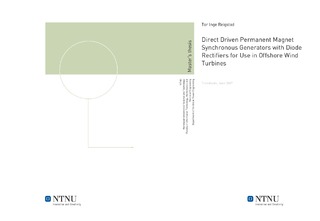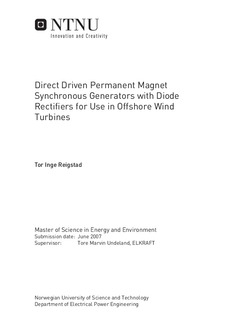| dc.description.abstract | This work is focused on direct-driven permanent magnets synchronous generators (PMSG) with diode rectifiers for use in offshore wind turbines. Reactive compensation of the generator, power losses and control of the generator are studied. Configurations for power transmission to onshore point of common connection are also considered. Costs, power losses, reliability and interface with the PMSG are discussed. The purpose of the laboratory tests and simulations are to learn how a PMSG with diode rectifier behaves. A 55kW PMSG is tested in "Vindlabben", with and without reactive compensation. The generator current and generator voltage are measured and the total harmonic distribution (THD) of the current and the voltage are calculated. The results are compared to simulations on an equal generator in PSCAD/EMTDC. A 2MW PMSG is also simulated to compare parallel and series compensation and to find how the generator efficiency varies with the wind speed. The generator is also simulated with constant DC-link voltage and varying local wind to find how much the turbine and generator efficiency decreases when a Cluster step-up configuration is used. The DC-link voltage is in this case equal for parts of the wind farm or the whole wind farms. A 3MW ironless PMSG with very low synchronous reactance is simulated to find how this generator behaves with a diode rectifier. The laboratory tests and PSCAD simulations show that the maximal generator power increases when reactive compensation of the generator is used. The measured and simulated generator voltage and current shapes are found to be approximately equal. Series compensated PMSGs have lower generator current rms and lower current THD than parallel compensated PMSGs when the synchronous reactance is large. Therefore, the generator losses are 2-15% lower and the diode rectifier losses are 0-1% lower, depending on the wind speed. The diode rectifier losses are lower than 1%. The losses can be reduced even more if the diodes are connected in parallel. If a Cluster step-up configuration is used, the turbine efficiency is reduced by 3-4%. %The generator efficiency is more or less the same. The ironless PMSG has a low synchronous reactance and reactive compensation is not needed because the reactive power produced by the generator is low. Parallel connected capacitors have no positive effect and series connected capacitances must be very large and can therefore not be used. The generator current THD is very large when no reactive compensation is used. However, the current THD can be reduced by connecting an inductance to the DC-link. Cluster step-up, two-step DC/DC system, turbine step-up and series connected wind turbine are the most relevant layouts of the wind farms transmission system discussed in this thesis. The cluster step-up system has low power losses since only one large DC/DC converter is used. Also, the power equipment in the turbine is very reliable. However, the turbine efficiency is reduced since the generator torque and generator speed could not be controlled for one specific turbine. The other transmission systems require DC/DC converters in the turbines and they are therefore probably not as reliable. The total cost is crucial for the chose of the transmission system. Further cost accountings for the different DC systems are needed. | nb_NO |

